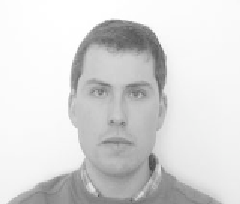Game Development Reference
In-Depth Information
Figure 4: Upper row: Original video frames; Lower row: Corresponding
frames of illumination-compensated sequence with constant lighting.
N
−
1
()
()
(
()
)
∑
I
C
shaded
x
=
I
C
unshaded
x
⋅
α
C
i
L
u
x
.
(6)
i
i
=
0
is set up. Since each pixel
x
being part of the object contributes one equation, a
highly over-determined linear system of equations is obtained that is solved for
the unknown
C
i
α 's in a least-squares sense. Rendering the 3-D object model
with the shaded texture map using the estimated parameters ,
C
i
α leads to a
model frame which approximates the lighting of the original frame. In the same
way, the inverse this formula can be used to remove the lighting variations in real
video sequences as it is shown in Figure 4.
Applications
In this section, two applications, model-based coding and facial animation, are
addressed which make use of the aforementioned methods for facial expression









Search WWH ::

Custom Search